Are you considering adding an Australian Cattle Dog or Blue Heeler to your family? This energetic, intelligent dog is a favorite for dog sports, ranch work and family companionship. If you are curious about the price of a Blue Heeler, you’ll find that the price of depends on several factors, most especially where you are obtaining the dog. In this post, we’ll look at the price — as well as the pros and cons — of obtaining a Blue Heeler or Red Heeler from a breeder, a breed rescue and a shelter, comparing the services you’ll receive from each.
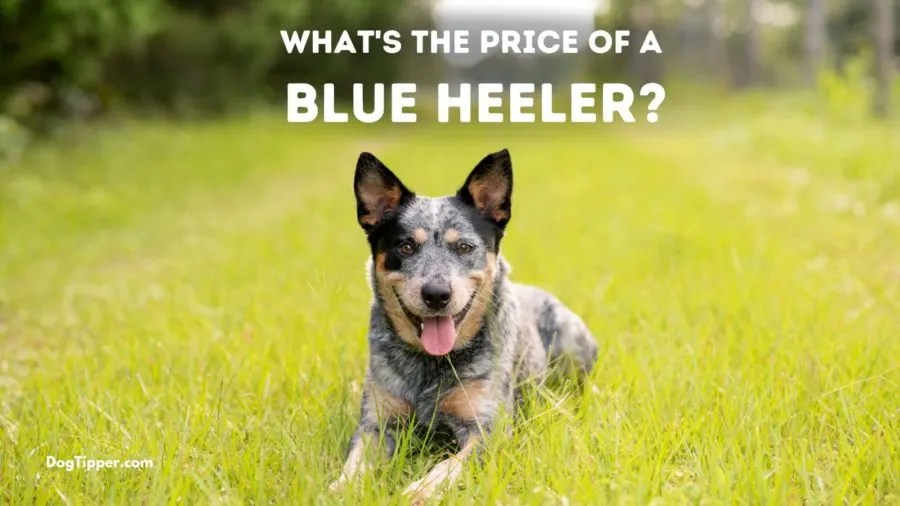
Our Australian Cattle Dog Spotlight: Alby
Two decades ago at the end of the summer, we pulled in our road to find a thin, thirsty young dog at our gate. We searched for her owners but soon came to realize she had been dumped on our road.
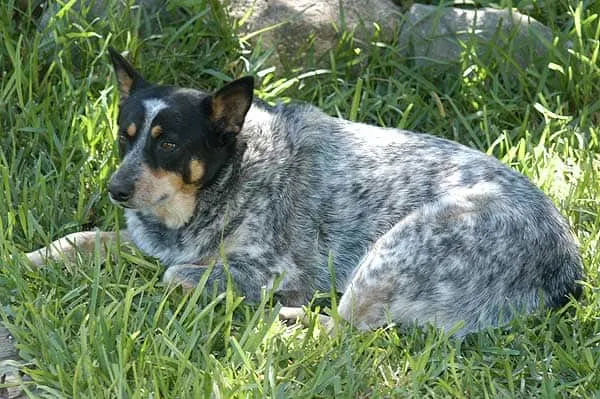
Our vet speculated that Alby–who we named for Australian adventure TV host Alby Mangels because she clearly had been on an adventure–was a purebred Australian Cattle Dog. (This was in pre-DNA testing days.) She was as smart as she was beautiful, a loving family member who was always alert and vigilant.
Did You Know? The Australian Cattle Dog is also known as the Blue Heeler, Red Heeler, Queensland Heeler, ACD, Cattle Dog or just Heeler. This breed was developed in Australia, combining Blue Smooth Highland Collies, Australian Kelpies and Dingos, the wild dogs of Australia.
How Much Does an Australian Cattle Dog Cost from a Breeder?
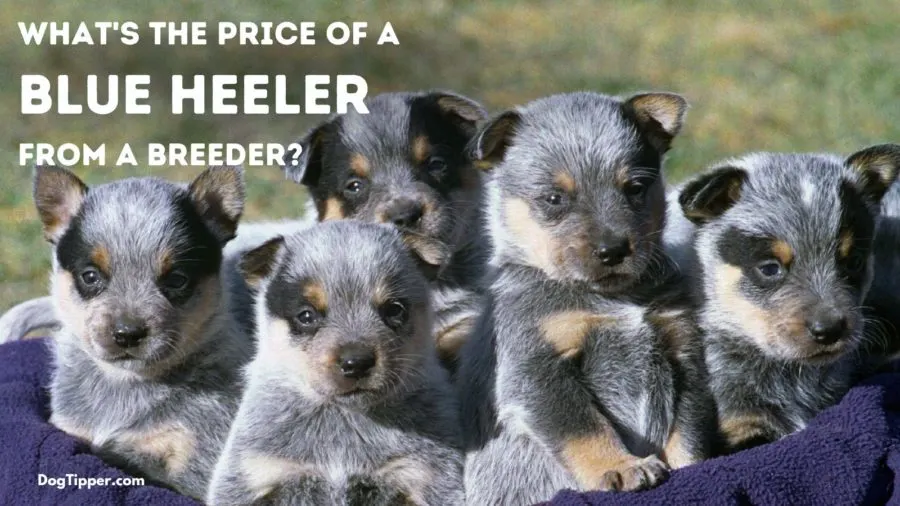
The price of a Blue Heeler puppy can range anywhere from $400-$1,200, with some lines reaching as much as $3,000.
The price will depend on several factors:
- The genetic testing that has been done on the Blue Heeler puppy’s parents. The best ACD breeders will have dogs that have passed health screenings and have Canine Health Information Center (CHIC) numbers. Dogs can only be granted a CHIC number by taking mandatory health screenings. (You’ll find a list of the mandatory health screenings–and the optional screenings–in the health section below.)
- The location of the breeder. The rules of supply and demand pertain to dogs as well so larger metropolitan areas are often more expensive. Here in Texas, Australian Cattle Dogs and Heeler mixes are pretty common so prices are lower than in some parts of the country.
- The pedigree of the parents. ACDs that have participated in sanctioned competitions have more expensive litters.
- Whether the Australian Cattle Dog is a show quality dog, a working dog line or a pet quality dog. Most breeders will require that pet quality dogs be spayed/neutered at the appropriate age. Show quality puppies with a future in competitive dog shows and breeding are more expensive. ACDs from a working line are bred with an eye on behavior, not for the same looks as a show dog.
- The age of the dog. Puppies are definitely most expensive.
- The color of the ACD. AKC recognized four colors: Blue, Blue Mottled, Blue Speckled, Red Mottled and Red Speckled. Prices for Red Heelers can sometimes be more expensive than the more common Blue Heeler.
When you purchase a Blue Heeler or Red Heeler from a breeder, the price usually includes the dog’s registration papers and shots. Good breeders will also include a health guarantee.
When adopting from a breeder, it’s especially important to make sure you are adopting from a reputable breeder—not a backyard breeder and not an online seller. Below we’ll look at how you can be sure you are talking with a responsible Australian Cattle Dog breeder.
Health Tests for ACDs
Be sure to ask about which tests and evaluations the puppy’s parents have undergone before you make your purchase.
Like all breeds, Australian Cattle Dogs are susceptible to several orthopedic and hereditary diseases—so reputable breeders will conduct testing on both parents to help ensure a healthy litter.
The Australian Cattle Dog Club of America recommends these tests as mandatory for the parents of ACD puppies:
- The Orthopedic Foundation for Animals (OFA) or OVC evaluations for Hip Dysplasia. These tests can only be done on breeding dogs two years and older.
- The Orthopedic Foundation for Animals (OFA) or OVC evaluations for Elbow Dysplasia.
- Annual OFA Eye Certification exams (previously called CERF exams) by a Board Certified Canine Ophthalmologist; the exam should be is registered with OFA. This exam is done on breeding dogs age 2 or older.
- OFA evaluation for congenital deafness based on BAER test.
- Primary Lens Luxation DNA test from an approved lab.
And these tests are highly recommended:
- OFA evaulation for Patellar Luxation
- Cardiac Evaluation
- Progressive Retinal Atrophy RCD4
- Radiographic consultation for OCD (osteochondrosis dissecans) of the hocks looking for cartilage that can cause lameness
- PennHip test for measuring laxity that could indicate future risk for dysplasia
If you adopt a rescue Blue Heeler or Red Heeler, you most likely won’t have the benefit of these tests–but you can run the Embark Dog DNA Test using a simple saliva test you can perform at home. It tests for over 215 genetic diseases and conditions–including Primary Lens Luxation. (Embark can also test to see if your new dog is an ACD or combination of the 350+ breeds in its database.)
How to Find a Reputable Australian Cattle Dog Breeder
- Check the Breeder Directory at the Australian Cattle Dog Club of America.
- Attend a sanctioned dog show and talk with breeders and competitors for recommendations.
- Ask your veterinarian for recommendations regarding reputable breeders.
Once you’ve found a few names, do an online search to learn more and narrow your list.
Search for “BREEDER NAME complaints” or “BREEDER NAME scam” to see if you find complaints. Are there any Better Business Bureau (BBB) complaints? Check the Facebook page of the breeder and read through the comments. (Remember, however, that comments can be deleted by the page owner.)
Once you’ve narrowed your choice, it’s time to talk to the breeder:
- Ask for references. The breeder should be happy to share the name and contact information for customers.
- Ask questions. Lots of questions. The breeder should be happy to answer questions about the puppy, the puppy’s parents (and grandparents!), the socialization the puppy has received, the health tests and screening he has received and more. The breeder should be glad to share the test results from the health tests and screenings and should be happy to let you meet at least the mother (if not the sire as well) of the Australian Cattle Dog puppies.
- Ask how often the dogs are bred. A breeder shouldn’t have Cattle Dog puppies for sale at all times; reputable breeders will selectively breed and only have puppies for sale occasionally.
- Ask to tour the kennels. Are they well maintained? Do the dogs look healthy? Beware of operations that will not let you tour the kennels and breeders that want to meet you in a parking lot to hand over the puppy.
- Be prepared for questions. The breeder should ask YOU questions as well; be suspicious if the breeder has no questions about your past history with pets, your living situation, etc. The breeder should want to know how much experience you have with herding breeds, what your training plans are and your plans for exercising the dog. (ACDs require a lot of exercise!)
- Ask if the breeder will take the Heeler back if necessary. Reputable breeders should not only agree to accept the dog if it doesn’t work out or even upon your death—but require that the dog be returned to them for rehoming.
- Ask for a contract. VCA Animal Hospital recommends that the breeder “Provides a written contract with a guarantee of health allowing time for a pre-purchase examination by a veterinarian of your choice. If medical problems are diagnosed, the breeder should readily take the pup back and provide a full refund.”
- Ask for registration papers in your name.
Australian Cattle Dog breeders may adopt out of the area but, nonetheless, you will want to go to the breeder to meet the parents, view the kennels and bring home your puppy in person. This will add to your expenses—but breeders that transport a puppy by air are putting the dog at risk.
If you want to buy an Australian Cattle Dog from an online breeder, please think again. There are numerous scams; people spend thousands of dollars for a dog and never receive a puppy. AKC warns potential pet parents to be wary of any seller asking for payment by Venmo, in gift cards or as a wire transfer.
Sadly many dogs sold online and in pet shops are often the result of puppy mills, places where dogs live 24/7 in terrible conditions without human socialization and often with serious health issues. Dogs purchased from puppy mills can mean years of heartache and expensive veterinary care–and perpetuation of a cruel industry.
The pros of purchasing from an ACD breeder:
- You may be able to select a puppy—including a choice of color and gender.
- You may obtain health screenings for the puppy’s parents.
- A reputable breeder will be passionate about Heelers and will a resource for years to come.
The cons of purchasing from a ACD breeder
- You will pay far more for a cattle dog from a breeder than a rescue or shelter. If you find a breeder who has Blue Heeler puppies for sale at prices much lower than you are seeing from other breeders, you must suspect you are dealing with a backyard breeder who has not done health screening, with an online seller who is operating a puppy mill or with someone who is running a scam. Beware.
- You will need to wait until puppies are available.
- You will need to do your own due diligence to select a reputable breeder.
What’s the Price of Adopting an Australian Cattle Dog at a Breed Rescue?
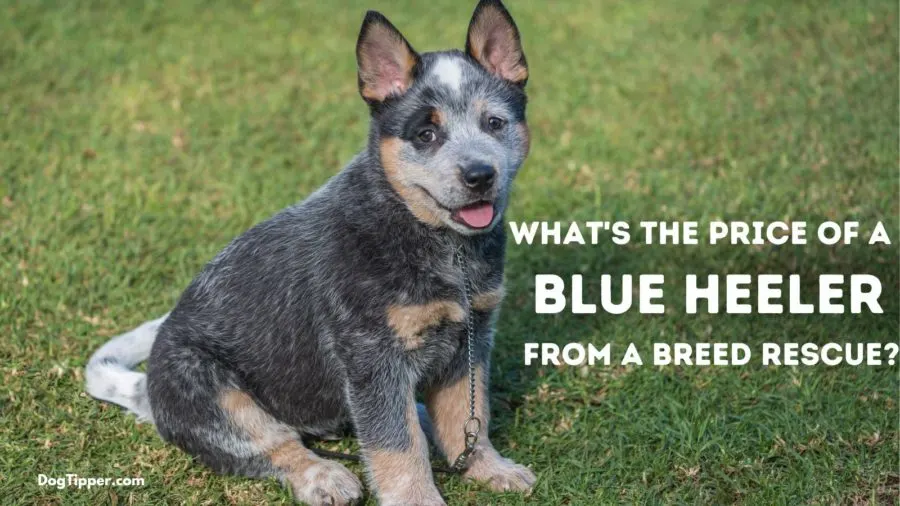
Australian Cattle Dogs in rescues are far less expensive that those at a breeder. Generally the price of a Heeler at an Australian Cattle Dog rescue will range from $150-$500, depending on the location and the age of the dog. Puppies under a year old will be the most costly.
A breed rescue is, like the name suggests, a pet rescue that is specifically for one breed of dog. You’ll find purebred cattle dogs, cattle dog mixes and probable cattle dogs at breed rescues.
These are generally small non-profit groups that operate through a foster system of volunteers who love the breed. Because of the time the dog spends in their home while waiting for adoption, the foster will be able to tell you about the dog’s personality, likes and dislikes–and what type of home this Heeler would do best in.
Also check with other herding breed rescues–we’ve seen Heelers for adoption at Border Collie rescues and Australian Shepherd rescues as well.
When you find a Blue Heeler or Red Heeler in a breed rescue, that puppy or dog will have received a long list of valuable services:
- Spay/neuter, in most cases
- Age appropriate shots
- Heartworm screening and monthly preventative
- De-worming
- Wellness visit
- Any veterinary care the dog may have required while waiting for adoption
The cost of these services, depending on your vet and the gender of your dog, could range from $300-500 if you went to purchase the same services.
Related post: 150+ Blue Heeler Names from the Land Down Under!
How to Find Breed Rescues
Many breed rescues list their adoptable dogs on large adoption sites such as:
Search these sites by breed to see if breed rescues in your area have adoptables. If you find a potential match, you’ll then make an application directly to the rescue. Breed rescues generally have more stringent adoption processes to ensure a good fit both for you and the Heeler. Some may require a home visit; most will want to do a veterinary check and a reference check with non-relatives.
The dogs that are up for adoption at Australian Cattle Dog rescues may be there for a variety of reasons:
- Death of an owner.
- Change in owner’s living situation. Maybe they moved out of pet-friendly housing, had health challenges, were no longer able to afford the cost of a dog, had a baby and no longer wanted a dog, got a new boyfriend who didn’t like dogs…the reasons run the gamut.
- Owners that weren’t ready for the challenges of an active herding dog.
- Lost dogs that the rescue had seen on shelter websites.
- Australian Cattle Dogs a breeder no longer wanted.
Whatever the reason, heelers in rescue may or may not come with papers, depending on whether or not the dog was surrendered with papers.
Cattle Dog Rescues
You’ll find numerous rescues devoted exclusively to the Australian Cattle Dog breed.
To find a breed rescue, search for “Australian Cattle Dog rescue near me” or “Blue Heeler rescue near me.” Some rescues will only adopt in state or to surrounding states due to the fact that many require a home visit.
Here’s a look at four with excellent websites that provide information not just on their adoptables but also on this beautiful and intelligent breed:
- Australian Cattle Dog Rescue Inc. The Board of Directors of this non-profit group are appointed by the American Kennel Club’s breed parent club, the Australian Cattle Dog Club of America.
- Arizona Cattle Dog Rescue. This non-profit group rescues heelers in Arizona and adopts them following a stay in the all-volunteer foster system.
- Australian Cattle Dog Rescue Minnesota. This group rescues heelers from primarily high-risk shelters.
- Texas Cattle Dog Rescue. Since 2009, this Texas-based non-profit rescue has rescued shelter heelers and housed them in their foster system until adoption. Their site includes an extensive list of cattle dog rescues in the US and Canada.
Here’s a look at some adoptable Heelers currently in rescue:
The Pros of Adopting from a Blue Heeler Rescue
- You will be saving a life. Most dogs at breed rescues are pulled from shelters, often open-intake shelters that may not be no-kill shelters.
- You will be able to adopt an Australian Cattle Dog or Australian Cattle Dog mix for far less money than purchasing a dog from a breeder.
- You will be able to talk with people who are passionate about the breed about the individual dog you are interested in adopting.
- You will have a network of assistance to help with your questions as you acclimate an Australian Cattle Dog into your life.
The Cons of Adopting from a Breed Rescue
- You may or may not be able to find an Australian Cattle puppy. Our most recent search brought up an 8-month-old ACD so it’s definitely a possibility.
- Unless the rescue knows the history of the dog, you most likely won’t know if the dog’s parents had the health screenings we discussed above.
- Your dog may or may not be a purebred Australian Cattle Dog and may or may not have papers. Some dogs are turned into breed rescue by owners who have papers and a full background on the dog, however.
What’s the Price of Adopting a Heeler at a Shelter?
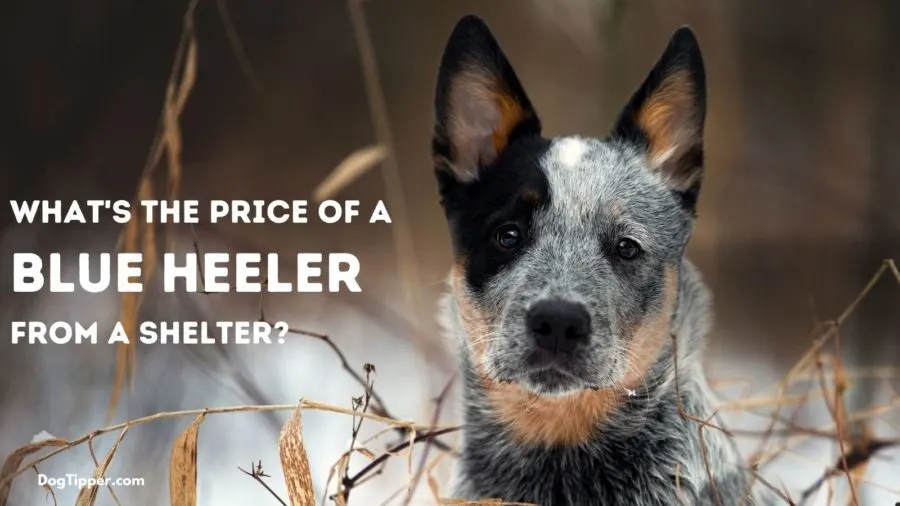
The least expensive option when it comes to the price of an Australian Cattle Dog is the shelter, either a municipal animal shelter or a privately-operated shelter. Generally you can expect to pay $50-150 at a municipal shelter and slightly more at a privately-operated shelter.
At a shelter or in online shelter listings, you are going to have to rely more on your knowledge of the heeler appearance than you would at a breed rescue. Just because you see a puppy listed as an Australian Cattle Dog, it may or may not be. Shelters use their best judgement, often while intaking many dogs, so sometimes the accuracy of the breed is questionable. And a growing number of shelters don’t attempt to guess at the breed of a dog but instead label them as “mixed breed” in the listings.
So how can you improve your chances of finding a cattle dog at a shelter? You can scroll through the listings–but you’ll want to look for the Blue Heeler’s distinctive look to identify a cattle dog. Here are some distinctive features:
- Check purebred photos and learn the look–at a variety of ages. Check purebred sites of breeders and the breed club to learn what Australian Cattle Dogs look like as puppies, juveniles and adults.
- Look for a mask. A mask–color surrounding the eye–is found on many heelers. Blue Heelers more often have bilateral masks (on both sides) while Red Heelers more commonly have no mask or a unilateral (one eye) mask.
- Look for a brush tail. ACDs have a natural full tail carried down. Sadly, some people continue to dock the tail of puppies so you can’t assume a dog with no tail or a short tail isn’t an Australian Cattle Dog but is instead an Australian Stumpy Tail Cattle Dog. They are not as common as ACDs.
- Look for almond-shaped brown eyes.
- Look for a “Bentley Mark” or “Bentley Star” on the forehead. This is a white patch high on the forehead; not all heelers will have one but the majority will. This patch (which can be small or large and appears on both blue and red heelers) can be traced back to Australia and the dog of Tom Hall, one who sired many heelers. As you can see, our Blue Heeler Alby had a large Bentley Mark:
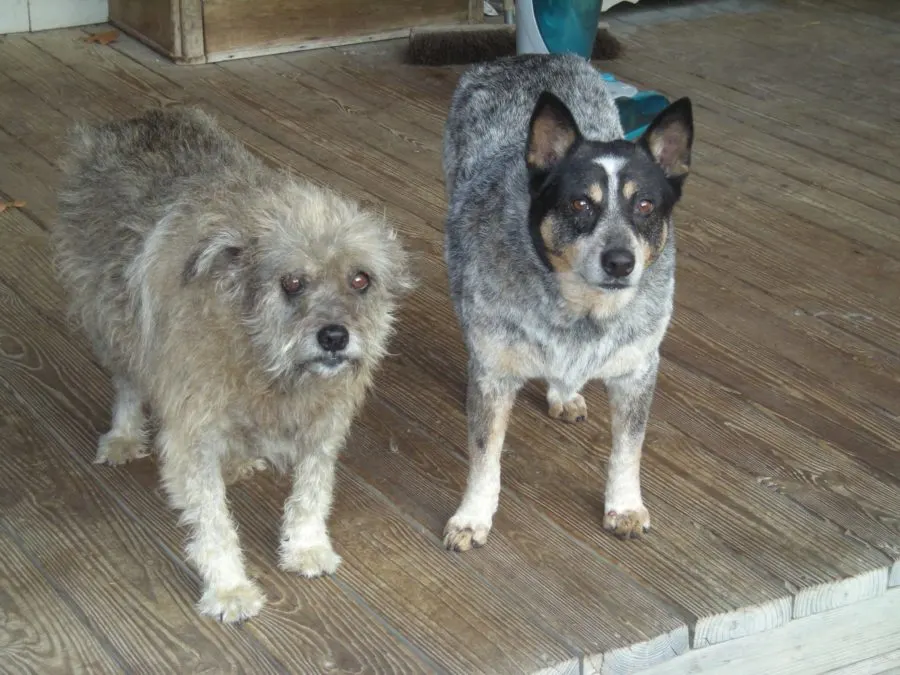
Like dogs at breed rescues, most shelter dogs have seen a veterinarian and received a whole suite of treatments including spay/neuter, shots appropriate for their age, deworming, microchipping and more. Purchased separately, those services can range from about $350 to $500.
To locate a heeler at a shelter, call your local shelter or start your search online. Petfinder’s Australian Cattle Dog page will list the total number of adoptable Australian Cattle Dogs currently in the database. Click on the link of adoptable dogs in the top left corner; you can then enter your zip code to see adoptables near you. The listings will include both rescues and shelters.
You can search for dogs by age and gender–and by distance (some shelters and rescues will adopt out of area). You can also search by color if you are set on a particular coat color.
As with adopting from a breed rescue, you’ll find that dogs have become homeless for a huge variety of reasons, often having nothing to do with the behavior of the dog but with changes to the owner’s living situation or lack of time to train and acclimate the dog properly.
Unlike adopting from a breed rescue, dogs at a shelter will generally be housed at the shelter (although an increasing number utilize foster homes whenever they can, especially for puppies). If the dog is housed at the shelter, you may not know a lot about his or her personality.
Talk with the shelter staff and ask if the dog has been temperament tested and if they can tell you if the dog is skittish, shy, outgoing, has any prior training, etc.
Ask the shelter if they have any background on the dogs; you may be surprised to find a puppy whose purebred mother came in as a pregnant stray dog and gave birth at the shelter. It definitely happens.
The Pros of Adopting an Australian Cattle Dog from a Shelter
- You are saving a life, not only of the dog you adopt but of the next dog who will be rescued due to the kennel that is now clear.
- Your new dog will have received a long list of veterinary services.
- You will have the love of a dog whose price was far less than that of a dog from a breeder.
The Cons of Adopting a Blue Heeler from a Shelter
- Your dog may or may not be a purebred or a heeler mix.
- You most likely won’t know if the dog’s parents had the health screenings we discussed above.
- You may not know the history of the dog.
What’s the Price of a Heeler Mix?
In general, a purposeful Cattle Dog mix or crossbreed is lower priced than a purebred Australian Cattle Dog–but that can vary with the mix. There are many purposeful mixes; one of the most common is the Texas Heeler, a mix of ACD and Australian Shepherd. Prices for Texas Heeler puppies range from about $400-$800.
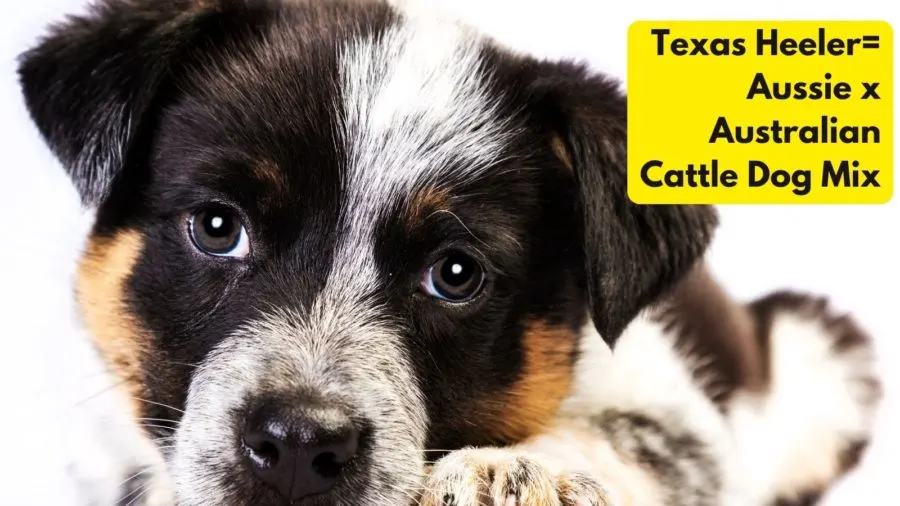
Of course, a Texas Heeler is one example of a purposeful mix; ACDs also create plenty of random mixes all on their own. You’ll find Heeler mixes in both breed rescues and in shelters at prices far less than through breeders.
Pin it to remember the Price of an Australian Cattle Dog
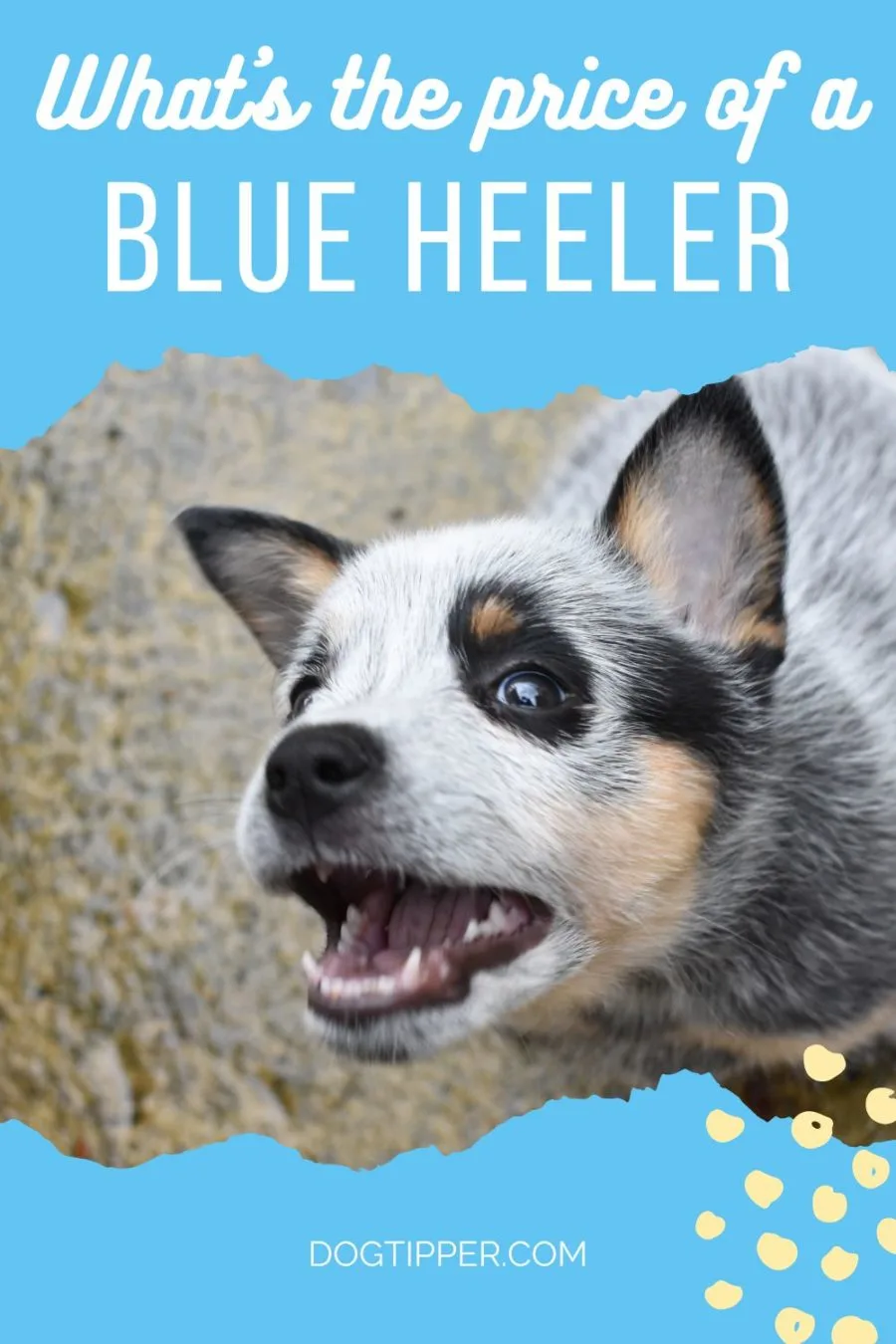
- Review: Jimmy BX7 Pro Anti-Mite Vacuum Cleaner - December 16, 2024
- 🎉 GIVEAWAY: Lord of the Pets Portrait of Your Dog! - November 26, 2024
- Review: Lord of the Pets Portraits - November 17, 2024
